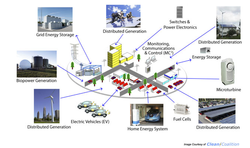
As defined by the U.S. Department of Energy Microgrid Exchange Group, a microgrid is "a group of interconnected loads and distributed energy resources within clearly defined electrical boundaries that acts as a single controllable entity with respect to the grid. A microgrid can connect and disconnect from the grid to enable it to operate in both grid-connected or island-mode."
Earlier considered mainly because of their ability to island (i.e., operate independently from the grid) and serve remote areas, microgrids are now experiencing mainstream adoption as communities, companies, and governments recognize the key benefits of microgrids in terms of resiliency and energy security.
The following events can be credited with bringing microgrids into the public spotlight.
1. The year 2017 saw many tragic natural disasters that not only resulted in loss of human life, but also disrupted entire communities for days, weeks, and months. Power outages cost nations millions not only due to infrastructure rebuilding requirements but also due to decreased economic activity. Hurricanes Maria, Irma, and Harvey, all brought attention to the potential advantages of having a microgrid at times of large-scale grid failure, and with resulting news articles and discussions on the topic, microgrids increased their public profile.
2. Another event that got attention was not a grid failure but rather a local accident that caused one of the busiest airports of the world, Atlanta, to have an eleven hour long blackout in December 2017. The resulting chaos from stranded travelers and delayed flights again brought focus on the need for utilities to modernize and implement more resilient options.
In addition, a major energy security concern that is receiving increased attention is the potential for central grid sabotage by non-state actors. The threat of intentional hacking of the grid to cause power failure to harm the nation’s economy is a real possibility and has many policy makers thinking about cybersecurity. One solution highlighted is dividing the grid into many smaller ones to avoid a large scale central disruption. This can be accomplished by deploying microgrids.
Some energy companies and utilities realized the importance of microgrids five years ago after Hurricane Sandy, but for many others 2017 was a threshold year. A November 2017 report by GTM Research forecasts $12.5 billion in microgrid investment within the United States over the next six years, and states from California to New York are implementing policies to accelerate microgrid commercialization and deployment.

 RSS Feed
RSS Feed